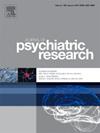Transcriptomic markers of psychoactive substance addiction in peripheral blood
IF 3.2
2区 医学
Q1 PSYCHIATRY
引用次数: 0
Abstract
The regular use of psychoactive substances, resulting in substance use disorders, represents a significant public health concern globally. Due to genetic variability and the substantial impact of environmental factors, identifying specific genes associated with predisposition to addictive behaviors presents a significant challenge. Regular exposure to psychoactive substances is known to change gene expression levels in the brain regions for reward and motivation. These changes affect the dopaminergic, glutamatergic, and cannabinoid systems of the brain. The existing data on cellular gene expression in the central nervous system has been predominantly derived from postmortem brain samples or animal models, which limits their clinical applicability. Therefore, analyzing gene expression levels in peripheral blood may provide considerable advantages for clinical practice. In this study, we conducted a differential gene expression analysis followed by a pathway analysis in individuals with long-term substance use disorders, such as opiates, psychostimulants, and cannabinoids. Our results revealed a significant number of genes exhibiting differential expression in peripheral blood. The pathway analysis suggested that the metabolic changes associated with regular substance use primarily impact energy catabolism, toxin metabolism, anabolic processes, and cell signaling pathways. The examination of peripheral blood transcriptome profiles provided valuable insights into the overall health status of individuals with substance use disorders related to various classes of psychoactive substances. Transcriptome analysis has the potential to significantly enhance the diagnosis of substance use disorders.
外周血中精神活性物质成瘾的转录组学标志物
经常使用精神活性物质,导致物质使用障碍,是全球一个重大的公共卫生问题。由于遗传变异和环境因素的重大影响,确定与成瘾行为易感性相关的特定基因是一项重大挑战。已知经常接触精神活性物质会改变大脑中奖励和动机区域的基因表达水平。这些变化影响大脑的多巴胺能、谷氨酸能和大麻素系统。现有的关于中枢神经系统细胞基因表达的数据主要来源于死后脑样本或动物模型,这限制了它们的临床适用性。因此,分析外周血基因表达水平可能为临床实践提供相当大的优势。在这项研究中,我们对长期物质使用障碍(如阿片类药物、精神兴奋剂和大麻素)患者进行了差异基因表达分析,然后进行了途径分析。我们的研究结果揭示了大量的基因在外周血中表现出差异表达。通路分析表明,与常规物质使用相关的代谢变化主要影响能量分解代谢、毒素代谢、合成代谢过程和细胞信号通路。外周血转录组谱的检查为了解与各类精神活性物质相关的物质使用障碍患者的整体健康状况提供了有价值的见解。转录组分析有潜力显著提高物质使用障碍的诊断。
本文章由计算机程序翻译,如有差异,请以英文原文为准。
求助全文
约1分钟内获得全文
求助全文
来源期刊

Journal of psychiatric research
医学-精神病学
CiteScore
7.30
自引率
2.10%
发文量
622
审稿时长
130 days
期刊介绍:
Founded in 1961 to report on the latest work in psychiatry and cognate disciplines, the Journal of Psychiatric Research is dedicated to innovative and timely studies of four important areas of research:
(1) clinical studies of all disciplines relating to psychiatric illness, as well as normal human behaviour, including biochemical, physiological, genetic, environmental, social, psychological and epidemiological factors;
(2) basic studies pertaining to psychiatry in such fields as neuropsychopharmacology, neuroendocrinology, electrophysiology, genetics, experimental psychology and epidemiology;
(3) the growing application of clinical laboratory techniques in psychiatry, including imagery and spectroscopy of the brain, molecular biology and computer sciences;
 求助内容:
求助内容: 应助结果提醒方式:
应助结果提醒方式:


